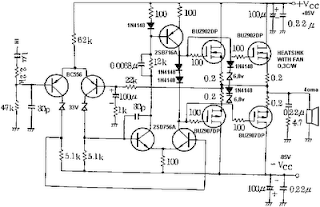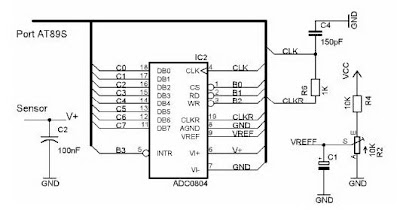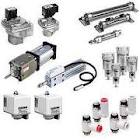Tuesday, November 11, 2014
This circuit was designed to ensure that an amplifier circuit containing a TDA1516Q would not exceed its maximum supply voltage when the load is small. This amplifier is used in a PC to increase the audio power somewhat. The PC power supply, however, created so much interference that an additional power supply was required.
Discrete Low-Drop Regulator Circuit Diagram
The power supply has its own power trans-former with a secondary voltage of 12 V AC. After rectification and filtering this results in a DC voltage of about 16 V. The regulator consists of a P-channel MOSFET SJ117, the gate of which is driven via a voltage divider connected to T2. The base of T2 is held at a constant voltage by LED D2, so that the volt-age across emitter resistor R2 is also constant and therefore carries a constant cur-rent.
When the output voltage is higher than about 13.5 V, zener diode D1 will start to con-duct and supply part of the current through R2 — as a result the MOSFET will be turned on a little less. In this way there is a balance point, where the output voltage will be a little over 13.5 V (1.5 V across R2 plus the 12 V zener voltage). The regulator is capable of deliver-ing up to about 2 A — in any case it is a good idea to fit the MOSFET with a heatsink.
It is possible to add an optional potentiometer in series with the 12-V zener diode, which will allow a small amount of adjustment of the output voltage.The relay at the AC powerline input ensures that the power supply is only turned on when the PC is turned on. This relay is driven from a 4-way power supply connector from the PC.
When the engine rpm becomes higher, the generated voltage of the generator also becomes higher and the voltage between the battery terminals becomes high accordingly. When it reaches the adjusted voltage of the integrated circuit and it is turned “ON”, a signal will be sent to the SCR (thyristor) gate probe and the SCR will be turned “ON”. Then the SCR becomes conductive in the direction from point A to point B. At this time the current generated from the generator gets through the SCR without charging the battery and returns to generator again.
Sunday, November 9, 2014

Notes:
The old and omnipresent NE555 can be very good at something it was not meant for: driving relays or other loads up to 200 mA. The picture shows an example circuit: if the input level rises over 2/3 of the supply voltage - it will turn on the relay, and the relay will stay on until the level at the input drops below one third of the supply voltage.
If the relay and D1 were connected between pin 3 and ground, the relay would be activated when the input voltage drops below one third, and deactivated when the input voltage goes over two thirds of the supply voltage.
It is also a nice advantage that the input requires only about 1 uA, which is something bipolar transistors cant compete with. (This high impedance input must not be left open.) A large hysteresis makes the circuit immune to noise. The output (pin 3) can only be either high or low (voltage-wise), and it changes its state almost instantenously, regardless of the input signal shape.
The voltage drop across the NE555s output stage (at 35-100 mA) is 0.3-2.0 V, depending on the way the relay is connected and the exact current it draws. D1 is absolutely vital to the safety of the integrated circuit.Source :: http://www.zen22142.zen.co.uk/Circuits/Switching/vcs555.htm
Saturday, November 8, 2014
The author is the happy owner of a television set with built-in Ambilight lighting in the living room. Unfortunately, the television set in the bedroom lacks this feature. To make up for this, the author attached a small lamp to the wall to provide background lighting, This makes watching television a good deal more enjoyable, but it ’s not the ideal solution. Although the TV set can be switched off with the remote control, you still have to get out of bed to switch off the lamp.
Circuit diagram :
Automatic TV Lighting Switch Circuit Diagram
Consequently, the author devised this automatic lighting switch that switches the background light on and off along with the T V set. The entire circuit is fitted in series with the mains cable of the TV set, so there’s no need to tinker with the set. It works as follows: R1 senses the current drawn by the TV set. It has a maximum value of 50 mA in standby mode, rising to around 500 m A when the set is operating. The voltage across R1 is limited by D5 during negative half- cycles and by D1– D4 during positive half-cycles. T he voltage across these four diodes charges capacitor C1 via D6 during positive half-cycles. This voltage drives the internal LED of solid-state switch TRI1 via R2, which causes the internal triac to conduct and pass the mains voltage to the lamp. Diode D7 is not absolutely necessary, but it is recommended because the LED in the solid-state switch is not especially robust and cannot handle reverse polarisation. Fuse F1 protects the solid-state switch against overloads. T he value of use d here (10 Ω) for resistor R1 works nicely with an 82-cm (32 inch) LCD screen.
With smaller sets having lower power consumption, the value of R1 can be increased to 22 or 33 Ω, in which case you should use a 3-watt type. Avoid using an excessively high resistance, as otherwise TRI1 will switch on when the TV set is in standby mode. Some TV sets have a half-wave rectifier in the power supply, which places an unbalanced load on the AC power outlet. If the set only draws current on negative half-cycles, the cir-cuit won’t work properly. In countries with reversible AC power plugs you can correct the problem by simply reversing the plug. Compared with normal triacs, optically cou-pled solid-state relays have poor resistance to high switch-on currents (inrush currents).
For this reason, you should be careful with older-model TV sets with picture tubes (due to demagnetisation circuits). If the relay fails, it usually fails shorted, with the result that the TV background light remains on all the time. If you build this circuit on a piece of perf-board, you must remove all the copper next to conductors and components carrying mains voltage. Use PCB terminal blocks with a spacing of 7.5 mm. This way the separation between the connections on the solder side will also be 3 mm. If you fit the entire arrangement as a Class II device, all parts of the circuit at mains potential must have a separation of at least 6 mm from any metal enclosure or electrically conductive exterior parts that can be touched.
Description
Here is a simple and humble 2 Watts mini audio amplifier circuit suitable for small pocket radios and other portable audio gadgets.The circuit is based on Phillips Semiconductors IC TDA 7052.The amplifier can be run even from a 3V Mercury button cell.This makes it ideal for battery operated gadgets.
The IC TDA7052 is a mono output amplifier coming in a 8-lead DI package (DIP). The device is mainly designed for battery-operated portable audio circuits. The features of TDA 7052 include ,no external components needed, no switch-on or switch-off click sounds , great overall stability ,very low power consumption(quiescent current 4mA) , low THD, no heat sinks required and short-circuit proof.
The gain of TDA 7052 is fixed internally at 40 dB. . To compensate the reduction of output power due to low voltage supply the TDA7052 uses the Bridge-Tied-Load principle (BTL) which can provide an output of around 1 to 2 W Rms(THD = 10%) into an 8 Ohm load with a power supply of 6 V.
In the circuit the potentiometer can be used to control the volume. Capacitor C1 and C2 are meant for filtering the supply voltage if a battery eliminator is used as supply source. For operations using a battery C1 and C2 are not necessary.
Mini Audio Amplifier Circuit Diagram with Parts List:
For simplicity, and assuming room temperature, we round this value to 40. For a single stage amplifier circuit with grounded emitter it holds that the gain Uout /Uin (for AC voltage) is in theory equal to SRc. As we observed before, the slope S is about 40Ic. From this follows that the gain is approximately equal to 40I cRc. What does this mean? In the first instance this leads to a very practical rule of thumb: that gain of a grounded emitter circuit amounts to 40·I c·Rc, which is equal to 40 times the voltage across the collector resistor.
If Ub is, for example, equal to 12 V and the collector is set to 5V, then we know, irrespective of the values of the resistors that the gain will be about 40R(12–5) = 280. Notable is the fact that in this way the gain can be very high in theory, by selecting a high power supply voltage. Such a voltage could be obtained from an isolating transformer from the mains. An isolating transformer can be made by connecting the secondaries of two transformers together, which results in a galvanically isolated mains voltage.
Circuit diagram:
That means, that with a mains voltage of 240 Veff there will be about 340 V DC after rectification and filtering. If in the amplifier circuit the power supply voltage is now 340 V and the collector voltage is 2 V, then the gain is in theory equal to 40 x (340–2). This is more than 13,500 times! However, there are a few drawbacks in practice. This is related to the output characteristic of the transistor. In practice, it turns out that the transistor does actually have an output resistor between collector and emitter.
This output resistance exists as a transistor parameter and is called ‘hoe’. In normal designs this parameter is of no consequence because it has no noticeable effect if the collector resistor is not large. When powering the amplifier from 340 V and setting the collector current to 1 mA, the collector resistor will have a value of 338 k. Whether the ‘hoe’-parameter has any influence depends in the type of transistor. We also note that with such high gains, the base-collector capacitance in particular will start to play a role.
As a consequence the input frequency may not be too high. For a higher bandwidth we will have to use a transistor with small Cbc, such as a BF494 or perhaps even an SHF transistor such as a BFR91A. We will have to adjust the value of the base resistor to the new hfe. The author has carried out measurements with a BC547B at a power supply voltage of 30 V. A value of 2 V was chosen for the collector voltage. Measurements confirm the rule of thumb. The gain was more than 1,000 times and the effects of ‘hoe’ and the base-collector capacitance were not noticeable because of the now much smaller collector resistor.
















 This
This  Parts Lits:- IC CMOS CD4066
Parts Lits:- IC CMOS CD4066









